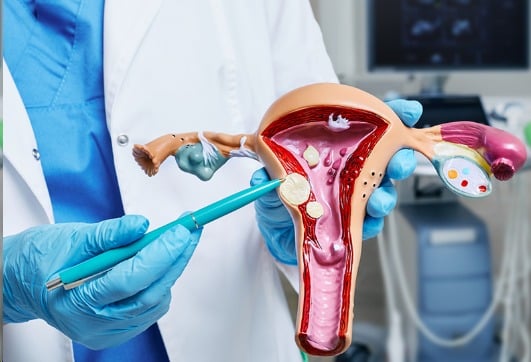Uterine fibroids are very common, affecting a large percentage of women, especially those in their 40s and early 50s. Most studies estimate a lifetime prevalence of 70–80% by the age of 50. Despite these high figures, the true prevalence is, however, believed to be underestimated. And Black women are disproportionately affected by uterine fibroids, with a higher prevalence, earlier onset, and more severe symptoms than women of other races. Due to the severity of their symptoms, Black women have higher rates of surgery for fibroid treatment.
Now, uterine fibroids are noncancerous tumours that grow in the uterus, also known as the womb. They are made of smooth muscle cells and other tissue and can range in size from that of an apple seed to as large as a grapefruit. Fibroids can grow on the outer wall of the uterus (subserosa), inside the muscle wall (intramural), or bulge into the uterine cavity (submucosal).
The exact cause of uterine fibroids is not known, but they are believed to be influenced by hormones and by genetic factors. Oestrogen and progesterone, which rise during reproductive years, seem to stimulate fibroid growth. Fibroids can run in families, suggesting a genetic component. Other substances in the body, such as insulin-like growth factor, can also affect fibroid growth.
Other potential factors include diets high in processed foods, red meat, and high-fat dairy and low in fruits and vegetables. Being overweight increases oestrogen levels, which can increase the risk of developing fibroids. Some chemicals, including phthalates found in certain products like hair relaxers and plastics, may disrupt hormones and increase fibroid risk. Higher hormone levels, linked to significant life stresses, may contribute to fibroid development. And some studies suggest a link between exposure to childhood abuse and the development of uterine fibroids.
Advertisement
The truth is that the majority of women with uterine fibroids experience no symptoms, and the growths are often found during a routine pelvic exam or pregnancy ultrasound. However, the location, size, and number of fibroids can cause a wide range of signs and symptoms, usually from mild to severe, which may include heavy menstrual bleeding. Affected women may soak through sanitary pads or tampons in less than an hour, need to double up on protection, or pass large blood clots. The menstrual bleeding may last seven days or more. Some people may experience spotting or bleeding between periods or find that their cycle becomes unpredictable. The uterine cramping can also be more intense than usual. Prolonged heavy bleeding can lead to a low red blood cell count, causing fatigue, weakness, headaches, and shortness of breath.
There can equally be a constant feeling of pressure or fullness, a dull ache, or sharp pain in the lower abdomen. Large fibroids can cause the stomach area to swell or become distended, and this sometimes makes a woman look pregnant. Fibroids growing on the back of the uterus can press on spinal nerves, and this causes pain in the lower back, hips, or legs.
Furthermore, the capacity of the bladder can be reduced when fibroids press on it, and this leads to a constant need to urinate. There can also be difficulty emptying the bladder, as the women may feel unable to completely empty their bladder, which can increase the risk of urinary tract infections. In addition, fibroids that press on the rectum can make bowel movements difficult.
Advertisement
Fibroids can cause pain during intercourse, especially if located near the cervix or lower part of the uterus. In some cases, fibroids, particularly submucosal fibroids, can affect fertility or lead to complications during pregnancy and labour.
Now, uterine fibroids cannot be entirely prevented, but a healthy lifestyle, including eating plenty of fruits, vegetables, and whole grains, may lower the risk of developing them. Maintaining a healthy body weight is equally beneficial and is recommended. Studies indicate a link between regular exercise and a lower risk of fibroids, possibly because it helps manage weight and hormone levels. Some research suggests that adequate vitamin D levels may help prevent fibroids from growing larger. While the link is still being studied, managing stress might also be helpful. In addition, excessive consumption of alcohol, especially beer, has been associated with a higher risk of fibroids, so it is better to minimise its intake or avoid it altogether.
It is important to point out that if the fibroids are small or asymptomatic, no treatment may be needed. “Watchful waiting” may, therefore, be recommended, especially in cases with mild or no symptoms. If fibroids are, however, already giving you pain or trouble, the good news is that there are treatment options. The factors that determine a treatment include the severity and type of symptoms, such as heavy bleeding or pressure and the desire for future pregnancy, as well as the size, number, and location of the fibroids.
Over-the-counter pain relievers like ibuprofen can reduce the pain and inflammation caused by fibroids. In addition, birth control pills (IUDs), intrauterine devices, and gonadotropin-releasing hormone (GnRH) agonists can help manage heavy bleeding and sometimes shrink fibroids, while certain medications can equally help reduce heavy menstrual bleeding.
Advertisement
Sometimes, minimally invasive procedures are necessary; at other times, surgical procedures may be required. The surgical procedures include myomectomy, where the fibroids are removed while the uterus is left intact, making it suitable for those who want to have children. In hysterectomy, the uterus is surgically removed, and this eliminates fibroids permanently but prevents future pregnancies. In endometrial ablation, the lining of the uterus is removed or destroyed to reduce heavy bleeding, but this is not an option for those who want to get pregnant in the future.
Much as uterine fibroids are a common reality for many women, they do not have to be a source of constant discomfort or fear since every woman’s journey with this condition is unique. The key is to understand exactly what they are, recognise their symptoms, and explore the wide range of available management and treatment options—from watchful waiting and medication to minimally invasive and traditional surgeries. In all of these, it is vital to establish an open and trusting dialogue with your doctor or healthcare provider and not hesitate to seek a second opinion, ask challenging questions, and advocate for a care plan that aligns best with your life, symptoms, and future goals, including fertility.
Ojenagbon, a health communication expert and certified management trainer and consultant, lives in Lagos.
Advertisement
Views expressed by contributors are strictly personal and not of TheCable.












